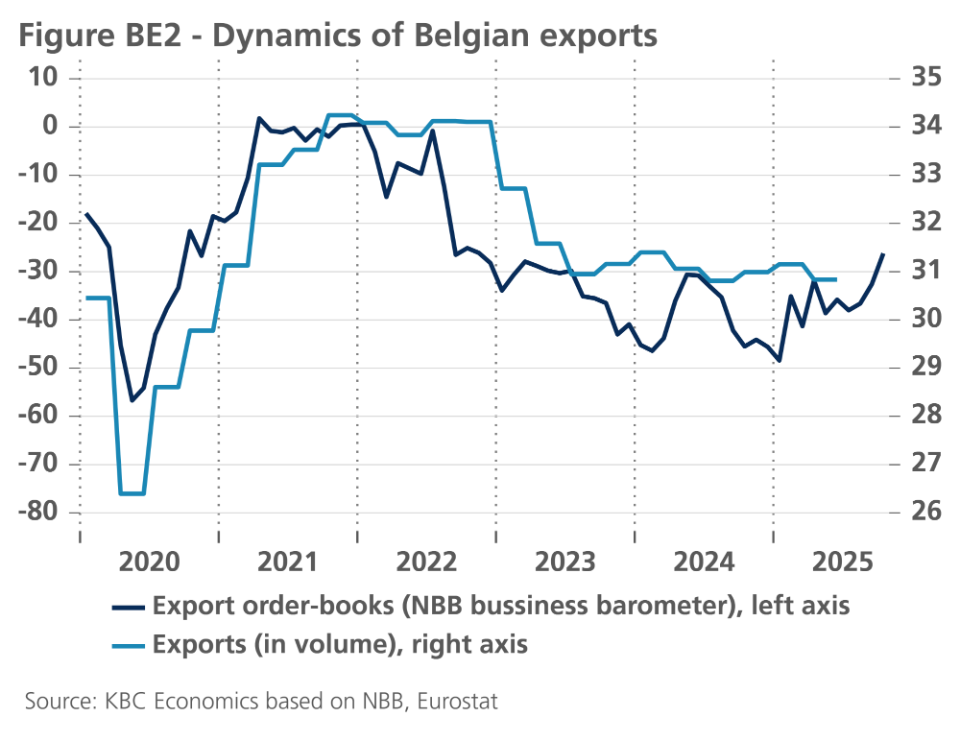Economic Perspectives for Belgium
Third quarter growth
According to the preliminary estimate of the National Accounts Institute (NAI), third quarter Belgian real GDP grew by 0.3% qoq. The figure was stronger than what we had expected (0.1%) and followed an upwardly revised 0.23% expansion in the second quarter (from 0.17% published previously). A longer series of GDP data, from 2021 onwards, was revised by the NAI as part of the process to improve the quality of statistics. The general trend of Belgian economic activity did not change, but the annual growth figures for the individual years did. Annual real GDP growth in 2021 (6.3%), 2023 (1.7%) and 2024 (1.1%) appears to have been better compared to the previously released data (6.2%, 1.2% and 1.0%, respectively), while in 2022 (4.0%) it was worse (4.3% previously reported).
The Belgian Q3 2025 growth figure (0.3%) came out above that of the euro area (0.2%) (see figure BE1). Compared with neighbouring countries, Belgian growth was above that of Germany (0.0%) but below that of France (0.5%) and the Netherlands (0.4%).

The initial Q3 estimate shows that value added rose in all three main sectors. Value added growth in both services and construction strengthened, from 0.2% to 0.4% and from 0.7% to 1.3% respectively. After the contraction in Q2 (-0.1%), value added in industry increased by 0.2% in Q3. GDP component data for Q3 growth are not yet available. Likely, household consumption again proved resilient, while we assume that the fall-out from US tariffs on exports has been moderate, as suggested by the clear rebound in export-orders (see figure BE2).

Scenario changes
Sentiment indicators came in mixed in October. Consumer confidence continued to grow, with the rise due to a further sharp drop in concern about unemployment (once again mainly in Wallonia), while there was less optimism for the general economic outlook. On the negative side, the most notable indicator in October was the drop in sentiment in business-related services. In particular, expectations for employment in the sector were significantly less optimistic (see figure BE3). We stay on the cautious side for Q4 and see estimated qoq growth slowing a bit to 0.2% that quarter. Full year growth in 2025 is still seen at 1.0%. While Q3 growth came out stronger than expected, the growth overhang from 2024 into 2025 was revised down by the NAI from 0.32% to 0.25%. We kept quarterly growth dynamics in 2026 unchanged, but due to a higher overhang from 2025 into 2026 (now seen at 0.38% instead of 0.24% previously) full year growth in 2026 was revised upwards from 0.9% to 1.1%.

Belgian inflation based on the HICP came in at 2.5% in October, down from 2.7% in September. The decline was caused by lower energy and food inflation (at 1.2% and 2.7% in October, respectively), with core inflation (excluding energy and food) remaining stable at 2.6%. The positive inflation differential between Belgium and the euro area narrowed further, from 0.5 to 0.4 percentage points. For core inflation, the positive differential remained at 0.2 percentage points. We kept our outlook for annual Belgian HICP inflation in 2025 at 3.0%, but did lower the outlook for 2026 inflation, from 1.8% to 1.6%. The reason is that we brought the month-on-month changes of the main HICP components excluding energy (i.e. core goods, food, services) more in line with those in our scenario for euro area inflation.
Revision of public finances data
In mid-October, the NAI also published new revised figures on the finances of the various Belgian government levels. The revision concerns an update of the first estimate for the 2024 figures made in April, but also a revision of the figures for earlier years, this due to the availability of new budgetary data (e.g. from local governments) and to adjustments made to the GDP figures (see above). The revised data for 2024 came out slightly better than previously released. The general government deficit and debt were at 4.4% and 103.9% of GDP, respectively. In the earlier estimate made in April, the NAI assumed a deficit and debt in 2024 of 4.5% and 104.7% of GDP, respectively. In an Economic Brief, published on November 5th, we highlighted the updated budgetary data of the three regions (see ‘Belgian regional public finances 2010-2024 mapped out’).
